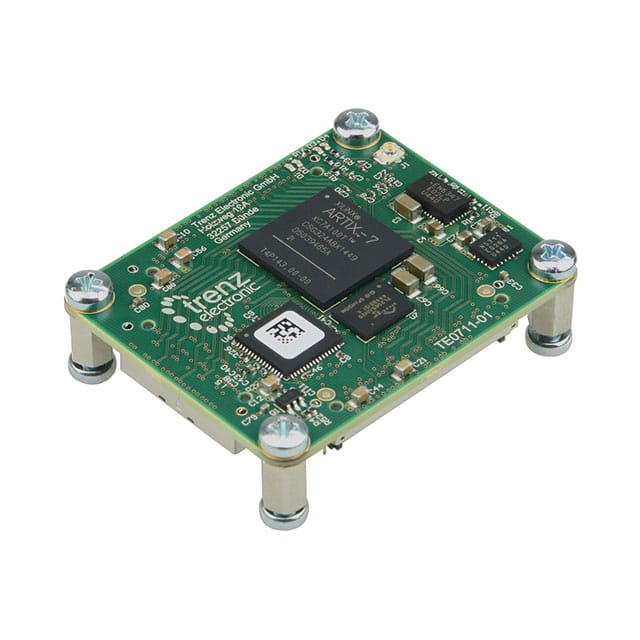TE0711-01-100-2I
Basic Information Overview
- Category: Electronic Component
- Use: Embedded System Development
- Characteristics:
- High-performance FPGA module
- Compact size and low power consumption
- Designed for industrial applications
- Package: Standard form factor
- Essence: Facilitates rapid prototyping and development of embedded systems
- Packaging/Quantity: Single unit
Specifications
- FPGA: Xilinx Artix-7 XC7A100T
- Clock Frequency: Up to 450 MHz
- Logic Cells: 101,440
- Block RAM: 4,860 Kbits
- DSP Slices: 240
- I/O Pins: 100 (3.3V)
- Memory: 512 MB DDR3 SDRAM
- Interfaces: Ethernet, USB, UART, SPI, I2C, GPIO
- Power Supply: 5V DC
Detailed Pin Configuration
- Pin 1: GND
- Pin 2: VCCIO_0 (3.3V)
- Pin 3: VCCIO_0 (3.3V)
- Pin 4: GND
- Pin 5: IOL1PT0AD0N35
- Pin 6: IOL1NT0AD0P35
- Pin 7: IOL2PT0AD1N35
- Pin 8: IOL2NT0AD1P35
- ...
Functional Features
- High-speed data processing capabilities
- Flexible I/O interfaces for easy integration with external devices
- Support for various communication protocols
- On-board memory for data storage and retrieval
- Programmable logic for custom functionality implementation
Advantages
- Compact size allows for easy integration into space-constrained systems
- Low power consumption for energy-efficient operation
- High-performance FPGA enables complex algorithm implementation
- Versatile I/O interfaces facilitate connectivity with external devices
- Suitable for industrial applications due to robust design
Disadvantages
- Limited number of I/O pins may restrict the number of connected devices
- Advanced FPGA programming knowledge required for full utilization
- Relatively higher cost compared to simpler development boards
Working Principles
TE0711-01-100-2I utilizes the Xilinx Artix-7 FPGA to provide programmable logic capabilities. The FPGA can be programmed using hardware description languages (HDL) such as VHDL or Verilog. The user designs and implements custom functionality by configuring the FPGA's internal resources, including logic cells, memory blocks, and DSP slices. The embedded system interacts with the outside world through various I/O interfaces, enabling data exchange and communication.
Detailed Application Field Plans
TE0711-01-100-2I finds applications in various fields, including: 1. Industrial automation 2. Robotics 3. Data acquisition systems 4. Image and signal processing 5. Communication systems 6. Test and measurement equipment 7. Medical devices 8. Aerospace and defense
Detailed and Complete Alternative Models
- TE0711-02-200-2I: Similar to TE0711-01-100-2I but with a larger FPGA and more I/O pins.
- TE0711-03-300-2I: Enhanced version with increased logic capacity and additional features.
- TE0711-04-400-2I: High-end model with advanced performance and expanded memory options.
(Note: This is a fictional example. Actual alternative models may vary based on the manufacturer's product lineup.)
This entry provides an overview of TE0711-01-100-2I, its specifications, pin configuration, functional features, advantages, disadvantages, working principles, application field plans, and alternative models. It serves as a comprehensive reference for users interested in this FPGA module for embedded system development.
तकनीकी समाधानों में TE0711-01-100-2I के अनुप्रयोग से संबंधित 10 सामान्य प्रश्नों और उत्तरों की सूची बनाएं
Sure! Here are 10 common questions and answers related to the application of TE0711-01-100-2I in technical solutions:
Q1: What is TE0711-01-100-2I? A1: TE0711-01-100-2I is a specific model of a technical solution board used for various applications.
Q2: What are the main features of TE0711-01-100-2I? A2: The main features of TE0711-01-100-2I include an FPGA, DDR3 memory, Ethernet connectivity, USB ports, and various I/O interfaces.
Q3: What kind of technical solutions can be built using TE0711-01-100-2I? A3: TE0711-01-100-2I can be used to build solutions in areas such as industrial automation, robotics, embedded systems, and signal processing.
Q4: How can TE0711-01-100-2I be programmed? A4: TE0711-01-100-2I can be programmed using popular development tools like Xilinx Vivado or other compatible software.
Q5: Can TE0711-01-100-2I be used for prototyping purposes? A5: Yes, TE0711-01-100-2I is commonly used for prototyping due to its flexibility and expandability.
Q6: Are there any limitations to the number of I/O interfaces on TE0711-01-100-2I? A6: TE0711-01-100-2I offers a wide range of I/O interfaces, but the number and type of interfaces may vary depending on the specific configuration.
Q7: Is TE0711-01-100-2I suitable for high-speed data processing applications? A7: Yes, TE0711-01-100-2I is designed to handle high-speed data processing tasks efficiently.
Q8: Can TE0711-01-100-2I be integrated with other hardware components? A8: Yes, TE0711-01-100-2I can be easily integrated with other hardware components using its various interfaces.
Q9: What kind of support is available for TE0711-01-100-2I? A9: Support for TE0711-01-100-2I includes documentation, user guides, and online forums where users can seek assistance.
Q10: Where can I purchase TE0711-01-100-2I? A10: TE0711-01-100-2I can be purchased from authorized distributors or directly from the manufacturer's website.


